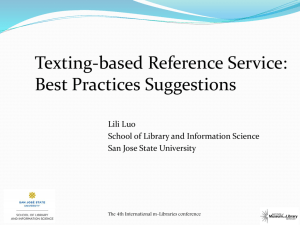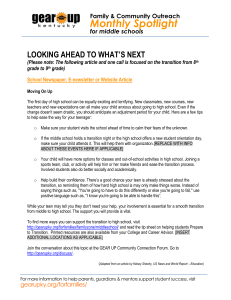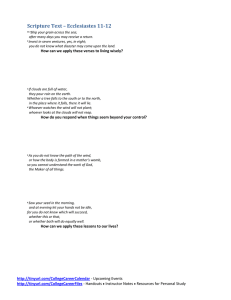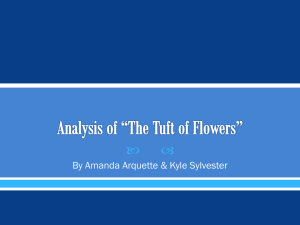Word doc
advertisement
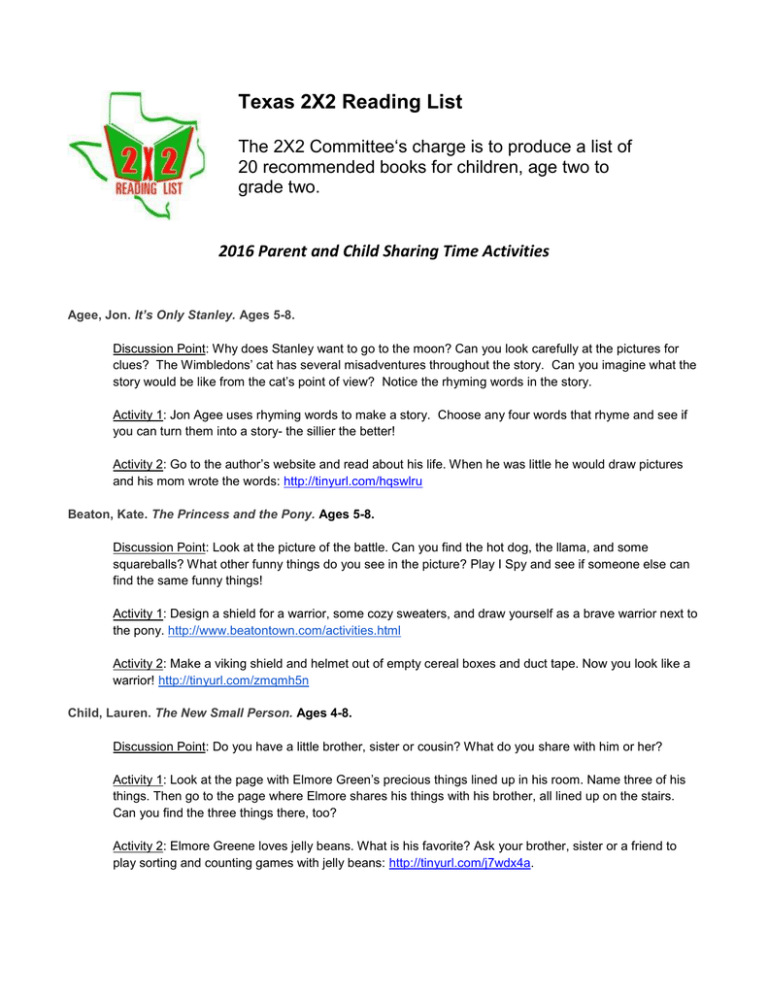
Texas 2X2 Reading List The 2X2 Committee‘s charge is to produce a list of 20 recommended books for children, age two to grade two. 2016 Parent and Child Sharing Time Activities Agee, Jon. It’s Only Stanley. Ages 5-8. Discussion Point: Why does Stanley want to go to the moon? Can you look carefully at the pictures for clues? The Wimbledons’ cat has several misadventures throughout the story. Can you imagine what the story would be like from the cat’s point of view? Notice the rhyming words in the story. Activity 1: Jon Agee uses rhyming words to make a story. Choose any four words that rhyme and see if you can turn them into a story- the sillier the better! Activity 2: Go to the author’s website and read about his life. When he was little he would draw pictures and his mom wrote the words: http://tinyurl.com/hqswlru Beaton, Kate. The Princess and the Pony. Ages 5-8. Discussion Point: Look at the picture of the battle. Can you find the hot dog, the llama, and some squareballs? What other funny things do you see in the picture? Play I Spy and see if someone else can find the same funny things! Activity 1: Design a shield for a warrior, some cozy sweaters, and draw yourself as a brave warrior next to the pony. http://www.beatontown.com/activities.html Activity 2: Make a viking shield and helmet out of empty cereal boxes and duct tape. Now you look like a warrior! http://tinyurl.com/zmqmh5n Child, Lauren. The New Small Person. Ages 4-8. Discussion Point: Do you have a little brother, sister or cousin? What do you share with him or her? Activity 1: Look at the page with Elmore Green’s precious things lined up in his room. Name three of his things. Then go to the page where Elmore shares his things with his brother, all lined up on the stairs. Can you find the three things there, too? Activity 2: Elmore Greene loves jelly beans. What is his favorite? Ask your brother, sister or a friend to play sorting and counting games with jelly beans: http://tinyurl.com/j7wdx4a. Dotlich, Rebecca Kai. Race Car Count! Illustrated by Michael Slack. Ages 3-6. Discussion Point: Can you find the numbers 1 to 10 as you count along in the book? Match the number in the sentence with the number on the car. Now find the page with your favorite Race Car color. What number is it? Repeat the two rhyming words in the sentences on that page. Activity 1: Create your own Race Car card, like the ones in the back of the book, using crayons and paper. Give your race car a number, a color and a name. What does your race car love and collect? Activity 2: What can you do with a race car? Race it on tracks! Use a toy race car or draw one to cut out. Build tracks using blocks or use these shapes to race your car around: http://tinyurl.com/gwpxtye. Goodrich, Carter. We Forgot Brock! Ages 4-8. Discussion Point: Talk about if you had an imaginary friend, what kind of adventures would you have? Talk about whether or not you thought Brock was imaginary. What does it mean that the children could see each other’s imaginary friends? Activity 1: Design your own imaginary friend. What would (s)he look like? Would they look like a human? An animal? Would they have unusual characteristics (like 16 arms)? Would they be green or polkadotted? Activity 2: Brock showed us that best friends can be anything (even imaginary)! Draw a picture of your best friend. Hers, Bridget. I, Fly: The Buzz About Flies and How Awesome They Are. Illustrated by Jennifer Plecas. Ages 4-8. Discussion Point: Prior to reading the book, discuss reasons we like butterflies. Do we like flies? Why or why not? While reading the book, create a Venn Diagram comparing and contrasting the fly to the butterfly. At the midpoint of the book (the page where the fly takes questions) discuss whether or not the fly’s life cycle should be studied instead or the butterfly’s. Take a vote and see if the fly’s arguments swayed them. Finish reading the book. Activity 1: Learn to draw the fly on the illustrator’s pinterest page: http://tinyurl.com/gm9nte4 Activity 2: Create the life cycle of a fly and butterfly on a paper plate http://tinyurl.com/hkejh2s and http://tinyurl.com/75fgppt. Higgins, Ryan T. Mother Bruce. Ages 2-5. Discussion Point: Look at Bruce on the cover, what type of person do you think Bruce is? What kind of character would let four goslings crawl and chew on them? Do you believe Bruce is really as grumpy as he looks? During the winter months, what do bears do? How about birds, what do they usually do in the winter? Activity 1: Visit the author’s website http://ryanthiggins.com/. Read some Mother Goose nursery rhymes. View other unusual pairings at http://tinyurl.com/zvxyxmd. Activity 2: Discuss hibernation of bears and migration of geese. View bears hibernating: http://tinyurl.com/h9gcalx London, Jonathan. Hippos are Huge! Illustrated by Matthew Trueman. Ages 5-8. Discussion Point: After reading discuss all of the new facts that you learned about Hippos. Were you surprised they were strong? Why? Were you surprised at how graceful and fast they were? How come? Talk about how we use our eyes and previous experience to make quick judgements that can prove to be incorrect. Activity 1: Make a paper plate hippo: http://tinyurl.com/h2bunr7 Activity 2: Compare Hippos to other large land animals. What makes them similar or different? Start with Rhinos and Elephants and move on from there! McCloskey, Kevin. We Dig Worms! Ages 4-8. Discussion Point: What interesting fact did you learn from the story? Activity 1: Go outside and dig. See if you can find a worm to observe. Did your observations raise any new questions? Get your parents to help you find the answers to your questions. Get your parents to help you find the answers to your questions. Activity 2: Learn more about worms from: http://tinyurl.com/z45rb5f. What experiments can you conduct? Nelson, Kadir. If You Plant a Seed. Ages 4-7. Discussion Point: Talk about what it means to be kind. Give examples. Talk about what it means to be selfish. Would you rather someone be selfish or kind to you? Look at the cover who do you think are the characters? Do you think the birds are part of the story? Activity 1: Plant a seed in a dixie cup and watch it grow: http://tinyurl.com/h6mm5nm Activity 2: Visit the author’s website and download the book’s discussion guide: http://tinyurl.com/hm4634t. Paschkis, Julie. Flutter and Hum/Aleteo y Zumbido. Ages 4-8. Discussion Point: This author is inspired by nature. What are things that inspire you to write? Activity 1: Act out a few of the poems and have people guess what animal you are imitating. Activity 2: Pick your favorite poem and try reading in Spanish. Does it rhyme in Spanish? Paschkis, Julie. P. Zonka Lays an Egg. Ages 4-7. Discussion Point: On the page with the egg that P. Zonka lays, you can see all the things that she observed in the world reflected in the egg. Talk about all the things you see in her egg. Activity 1: Read the author’s note in the back of the book, and then make your own Pysanky eggs! http://tinyurl.com/3mxy8np Activity 2: Get or make an egg shaker by putting beans or rice in a plastic easter egg. When you read the story, shake the shaker every time Gloria crows! You can find ideas here: http://tinyurl.com/zpfowhz Petty, Dev. I Don’t Want to Be a Frog. Illustrated by Mike Boldt. Ages 3-7. Discussion Point: Before reading the story, discuss with your child what animal he/she might like to be and why. After reading the story, discuss what is great about your child being just the way he/she is! Activity 1: Make a frog puppet out of a green piece of paper, and use it to help you tell the story. http://tinyurl.com/2cy6n2k Activity 2: Make a “Me Tree” or flower with each leaf or petal featuring one great thing about your child: http://tinyurl.com/j9ork7b Robinson, Michelle. There’s a Lion in My Cornflakes. Illustrated by Jim Field. Ages 3-6. Discussion Point: Have you ever had something that you really wanted and saved for it? Activity 1: If you could wish for anything, what would it be? Draw a picture of the item. Activity 2: If you were given a lion, what would you do with it? Write or tell a story of the adventures you would have with the lion. Rosenberg, Liz. What James Said. Illustrated by Matt Myers. Ages 5-8. Discussion Point: Talk about why the children on the bus may be depicted as stick figures and James is not. Notice other parts of the story where the same technique is used. Talk about how easily it is to misunderstand people and how James was misunderstood in the story. Activity 1: Sit in a large circle and play the telephone game to illustrate how easy it is to be misunderstood. Have the person starting the round whisper a silly sentence into the ear of the person to their right. The sentence can only be said once and not repeated. Compare the beginning and ending sentences to see if they match. Activity 2: Talk about how art can express people’s feelings. What colors and kinds of patterns would you use to express happiness? Anger? Sadness? Pick an emotion and draw a picture to represent it. Taylor, Sean. Hoot Owl, Master of Disguise. Illustrated by Jean Jullien. Ages 3-7. Discussion Point: Talk about the words and phrases that repeat in the story. Do they make the story more fun? Notice the similes that the author uses as the owl flies from creature to creature. Talk about what a simile is and how they are used to create imagery in your mind. Activity 1: Make a wise and clever owl of your own! Here are some ideas to get you started: http://www.playideas.com/25-owl-crafts/ Activity 2: Pair this book with the non-fiction book Where Else in the Wild by David M. Schwartz and Yael Schy and explore stunning photographs of real creatures camouflaging themselves to hide from prey. Activity 3: Check out the fun activities for the book from the publisher- http://bit.ly/1KiwOsV Tupera, Tupera. Polar Bear’s Underwear. Ages 2-5. Discussion Point: Can you imagine what different animals’ underwear would look like? What kind of underwear would a caterpillar wear? Activity 1: Make a flannel story to incorporate the days of the week into Polar Bear’s repertoire! http://tinyurl.com/z2btcev. Activity 2: Check out the publisher created activity kit: http://tinyurl.com/hgv7mcc Vernick, Audrey. First Grade Dropout. Illustrated by Matthew Cordell. Ages 4-7. Discussion Point: Talk about times that you’ve said or done something embarrassing. How did you feel? What made you feel better? What should you do if someone says or does something that they are embarrassed about? Activity 1: Work with a parent to act out a situation where someone does something that embarrasses them and how you can be a friend to them. Activity 2: Use the free app Puppet Pals to retell the story. Available for Apple products. Virjan, Emma J. What This Story Needs is a Pig in a Wig. Ages 3-6. Discussion Point: This story had a lot of animals. How many animals joined the pig in her boat? Who else wore something on his head? What was in the boat besides the animals? What happened after the pig sent the animals away? Activity 1: Write down words that rhyme from the book on index cards. Add some other words that rhyme. Now practice the words by playing RHYME GO FISH: http://tinyurl.com/pmdzhof. Activity 2: Choose your favorite animal in the book and try writing a story beginning with the words “What this story needs is a (your favorite animal) in a (word that rhymes with your favorite animal).” Draw pictures to go with your story and read it out loud. Willems, Mo. The Story of Diva and Flea. Ages 6-8. Discussion Point: Why do you think Diva’s owner had pictures of her all over the livingroom? Whose pictures do you have in your house? Why? How do you think Flea felt when he saw his picture next to Diva? Activity 1: Create your own map. Where do you live? What City? What State? What Country? Continent? Planet? look for examples here: http://tinyurl.com/a4tk25l. Activity 2: Make an Eiffel Tower using pretzel sticks, crackers and cream cheese. or make it out of materials you already have at home. http://tinyurl.com/zsyutet.
![2013 AP Physics 1st day power point curriculum night 2nd trimester[1].](http://s2.studylib.net/store/data/009829912_1-e1db909c08f2fa84c964bbb2e3dca121-300x300.png)
